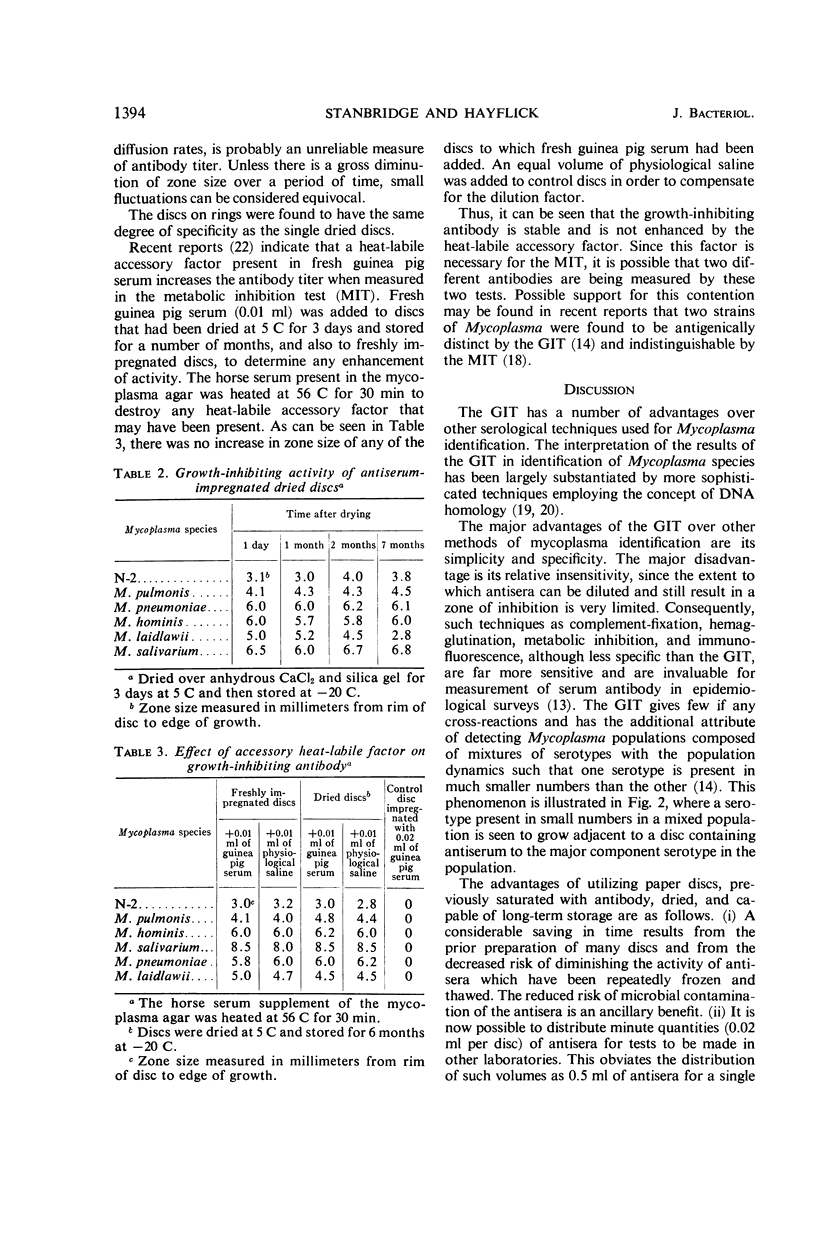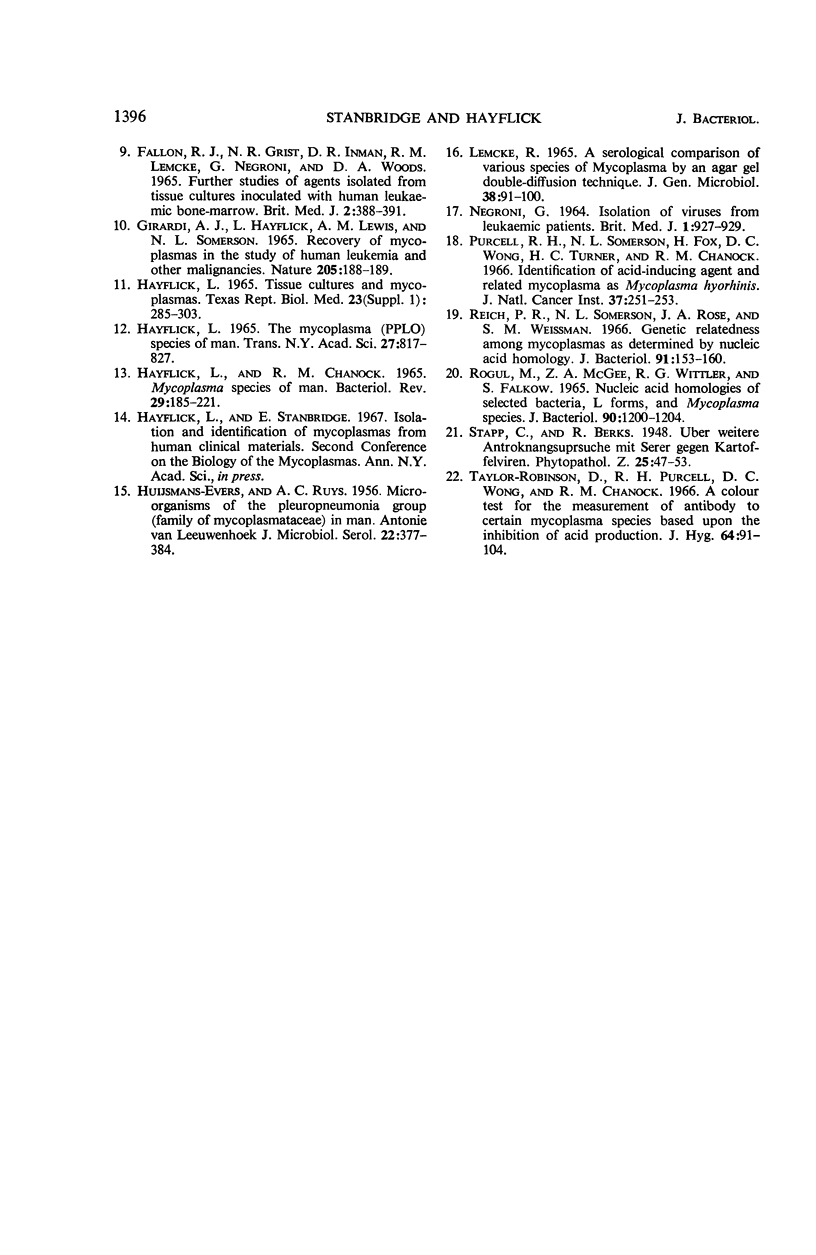Abstract
The growth inhibition test for identifying Mycoplasma species has been modified by drying antibody-impregnated paper discs at 5 C. When stored at −20 C, these discs have been found to retain their inhibitory activity for longer than 7 months. Since these discs can be stored for long period of time, significant advantages over present methods result. When, for example, discs are arranged on a ring, a single test can be used for the identification of an unknown human species. Valuable antisera can be distributed to other laboratories on paper discs in much less volume than can fluid antiserum. Considerable savings of time result from prior preparation of many discs that can then be stored and used over a long period of time. The growth-inhibiting antibody is stable, and the activity is not enhanced by a heat-labile accessory factor from fresh guinea pig serum which increases the antibody titer in the metabolic inhibition test.
Full text
PDF




Images in this article
Selected References
These references are in PubMed. This may not be the complete list of references from this article.
- ADAMS E., HANSON R. P. A procedure for adsorbing virus neutralizing antibodies on paper disks. J Bacteriol. 1956 Oct;72(4):572–572. doi: 10.1128/jb.72.4.572-572.1956. [DOI] [PMC free article] [PubMed] [Google Scholar]
- ANDERSON R. I., SADUN E. H., WILLIAMS J. S. A technique for the use of minute amounts of dried blood in the fluorescent antibody test for schistosomiasis. Exp Parasitol. 1961 Sep;11:111–116. doi: 10.1016/0014-4894(61)90014-5. [DOI] [PubMed] [Google Scholar]
- BRODY J. A. HAEMAGGLUTINATION-INHIBITION AND NEUTRALISATION TESTS USING WHOLE BLOOD DRIED ON FILTERPAPER DISCS. Lancet. 1963 Sep 21;2(7308):616–616. doi: 10.1016/s0140-6736(63)90402-1. [DOI] [PubMed] [Google Scholar]
- BRODY J. A., MCALISTER R., HASLEY R., LEE P. USE OF DRIED WHOLE BLOOD COLLECTED ON FILTER PAPER DISKS IN ADENOVIRUS COMPLEMENT FIXATION AND MEASLES HEMAGGLUTINATION INHIBITION TESTS. J Immunol. 1964 Jun;92:854–857. [PubMed] [Google Scholar]
- BUTLER M., LEACH R. H. A MYCOPLASMA WHICH INDUCES ACIDITY AND CYTOPATHIC EFFECT IN TISSUE CULTURE. J Gen Microbiol. 1964 Feb;34:285–294. doi: 10.1099/00221287-34-2-285. [DOI] [PubMed] [Google Scholar]
- CHANOCK R. M., HAYFLICK L., BARILE M. F. Growth on artificial medium of an agent associated with atypical pneumonia and its identification as a PPLO. Proc Natl Acad Sci U S A. 1962 Jan 15;48:41–49. doi: 10.1073/pnas.48.1.41. [DOI] [PMC free article] [PubMed] [Google Scholar]
- CLYDE W. A., Jr MYCOPLASMA SPECIES IDENTIFICATION BASED UPON GROWTH INHIBITION BY SPECIFIC ANTISERA. J Immunol. 1964 Jun;92:958–965. [PubMed] [Google Scholar]
- EDWARD D. G., FITZGERALD W. A. Inhibition of growth of pleuropneumonia-like organisms by antibody. J Pathol Bacteriol. 1954 Jul;68(1):23–30. doi: 10.1002/path.1700680104. [DOI] [PubMed] [Google Scholar]
- FALLON R. J., GRIST N. R., INMAN D. R., LEMCKE R. M., NEGRONI G., WOODS D. A. Further studies of agents isolated from tissue cultures inoculated with human leukaemic bone-marrow. Br Med J. 1965 Aug 14;2(5458):388–391. [PMC free article] [PubMed] [Google Scholar]
- GIRARDI A. J., HAYFLICK L., LEWIS A. M., SOMERSON N. L. RECOVERY OF MYCOPLASMAS IN THE STUDY OF HUMAN LEUKAEMIA AND OTHER MALIGNANCIES. Nature. 1965 Jan 9;205:188–189. doi: 10.1038/205188a0. [DOI] [PubMed] [Google Scholar]
- HAYFLICK L., CHANOCK R. M. MYCOPLASMA SPECIES OF MAN. Bacteriol Rev. 1965 Jun;29:185–221. doi: 10.1128/br.29.2.185-221.1965. [DOI] [PMC free article] [PubMed] [Google Scholar]
- HAYFLICK L. THE MYCOPLASMA (PPLO) SPECIES OF MAN. Trans N Y Acad Sci. 1965 May;27:817–827. doi: 10.1111/j.2164-0947.1965.tb02241.x. [DOI] [PubMed] [Google Scholar]
- HUIJSMANS-EVERS A. G., RUYS A. C. Microorganisms of the Pleuropneumonia group (family of Mycoplasmataceae) in man. II. Serological identification and discussion of pathogenicity. Antonie Van Leeuwenhoek. 1956;22(4):377–384. doi: 10.1007/BF02538351. [DOI] [PubMed] [Google Scholar]
- Hayflick L. Tissue cultures and mycoplasmas. Tex Rep Biol Med. 1965 Jun;23(Suppl):285+–285+. [PubMed] [Google Scholar]
- LEMCKE R. M. A SEROLOGICAL COMPARISON OF VARIOUS SPECIES OF MYCOPLASMA BY AN AGAR GEL DOUBLE-DIFFUSION TECHNIQUE. J Gen Microbiol. 1965 Jan;38:91–100. doi: 10.1099/00221287-38-1-91. [DOI] [PubMed] [Google Scholar]
- NEGRONI G. ISOLATION OF VIRUSES FROM LEUKAEMIC PATIENTS. Br Med J. 1964 Apr 11;1(5388):927–929. doi: 10.1136/bmj.1.5388.927. [DOI] [PMC free article] [PubMed] [Google Scholar]
- Purcell R. H., Somerson N. L., Fox H., Wong D. C., Turner H. C., Chanock R. M. Identification of acid-inducing agent and related mycoplasma as mycoplasma hyorhinis. J Natl Cancer Inst. 1966 Aug;37(2):251–253. [PubMed] [Google Scholar]
- Reich P. R., Somerson N. L., Rose J. A., Weissman S. M. Genetic relatedness among mycoplasmas as determined by nucleic acid homology. J Bacteriol. 1966 Jan;91(1):153–160. doi: 10.1128/jb.91.1.153-160.1966. [DOI] [PMC free article] [PubMed] [Google Scholar]
- Rogul M., McGee Z. A., Wittler R. G., Falkow S. Nucleic acid homologies of selected bacteria, L forms, Mycoplasma species. J Bacteriol. 1965 Nov;90(5):1200–1204. doi: 10.1128/jb.90.5.1200-1204.1965. [DOI] [PMC free article] [PubMed] [Google Scholar]
- Taylor-Robinson D., Purcell R. H., Wong D. C., Chanock R. M. A colour test for the measurement of antibody to certain mycoplasma species based upon the inhibition of acid production. J Hyg (Lond) 1966 Mar;64(1):91–104. doi: 10.1017/s0022172400040377. [DOI] [PMC free article] [PubMed] [Google Scholar]




